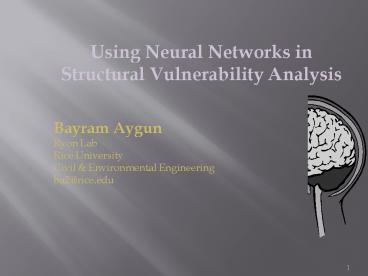Bayram Aygun - PowerPoint PPT Presentation
1 / 12
Title:
Bayram Aygun
Description:
Bayram Aygun. Ryon Lab. Rice University. Civil & Environmental Engineering. ba2_at_rice.edu ... Geotechnical Earthquake Engineering. Upper Saddle River, NJ: ... – PowerPoint PPT presentation
Number of Views:20
Avg rating:3.0/5.0
Title: Bayram Aygun
1
Using Neural Networks in Structural
Vulnerability Analysis
- Bayram Aygun
- Ryon Lab
- Rice University
- Civil Environmental Engineering
- ba2_at_rice.edu
2
Statement of the Original Problem
- Bridges are the most critical components of
modern transportation networks. Although these
networks provide the foundation for vibrant
economies, a lack of understanding persists about
the role that each bridge-soil system plays in
network performance when subjected to unforeseen
natural hazards such as earthquakes.
3
Why use neural networks (NNs)?
- Such a detailed bridge-soil model poses a
computational challenge when one wants to derive
its likelihood of failure or fragility when
subjected to natural hazards. - A neural network could be trained to approximate
the nonlinear, dynamic behavior of the FE model
and serve as a surrogate bridge model to evaluate
its response to seismic hazards. This approach
could save a lot of time.
4
Statement of the Problem Analyzed for the Project
- Because of the difficulties of gathering data the
original problem is scaled down to the analysis
of a 3-story truss building under static lateral
loads. This problem is not trivial because it
will give us insight on the potential of the
usage of NNs in structural fragility analysis.
5
Objective
- The objective is to train a feed forward, fully
connected neural network to mimic the behavior of
an FE model of 3-story truss building. Once the
network is trained it will be capable of
producing fragility values for unseen lateral
loads. These approximate fragility values will be
used to generate system fragility curve. The
analysis time is expected to decrease
drastically, thus justifying the use of surrogate
models.
6
Technical Approach on NN Training
- A three-layered, feed forward, fully connected NN
with nonlinear transfer functions ( tanh(x) ) in
every neuron is trained using error
backpropagation algorithm. - Bias neuron with constant input of 1 is
introduced at the input layer. - Momentum term is included in order to speed up
the convergence.
7
Technical Approach on NN Training Contd
- Batch Training is used and hence the error is
accumulated from all training data prior to
weight update (180 instances 1 epoch 1
iteration). - Error is calculated as follows
8
Some Training and Test Results
9
Some Training and Test Results Contd
10
Some Training and Test Results Contd
11
Conclusions and Further Research
- The multi-layer NN did a good job approximating
the fragility curve of the 3-story truss
building. - Further study should focus on getting enough data
for the original bridge-soil system and instead
of using static lateral loads earthquake
time-histories shall be imposed to the structure.
12
References
- Kramer,S. L. (1996). Geotechnical Earthquake
Engineering. Upper Saddle River, NJ Prentice
Hall International Series - Cosenza, E., Manfredi, G. (2000). Damage
Indices and damage measures. Prog. Struct. Engng.
Mater., 2, 50-59 - Marks, Roberts J. Artificial Neural Networks
Supervised Models?" (n.d). 5 April 2008
lthttp//cayman.globat.com/trademarksnet.com/Prese
ntations/index.htmgt. - Houmøller, Lars P. Neural Networks" (n.d). 4
April 2008 ltwww.acabs.dk/submenus/courses/Files/Ne
ural20networks.ppt gt.































